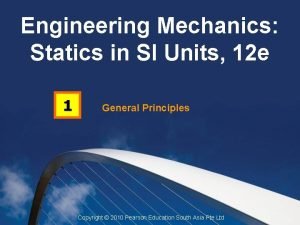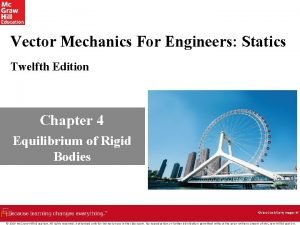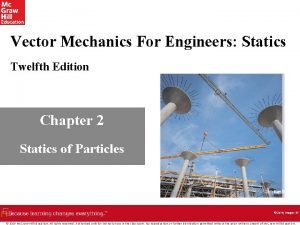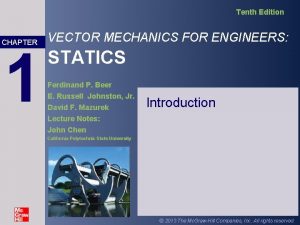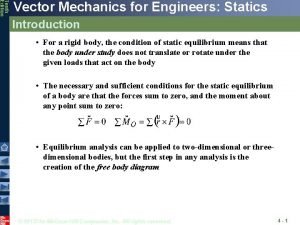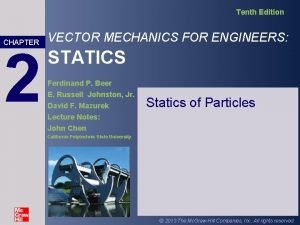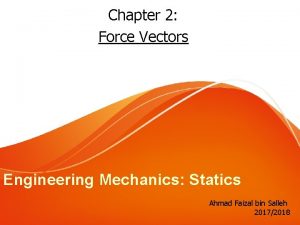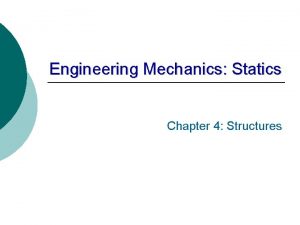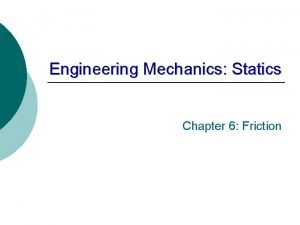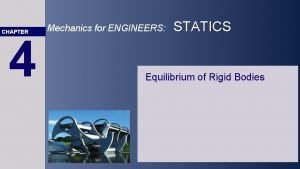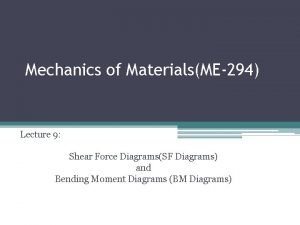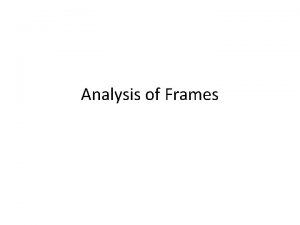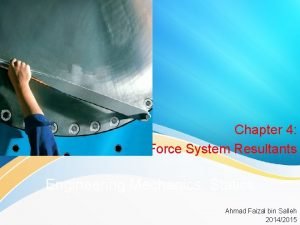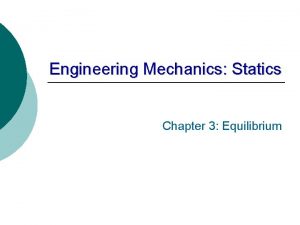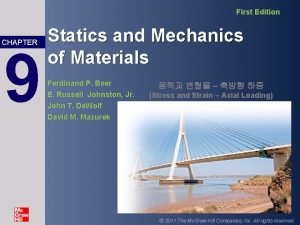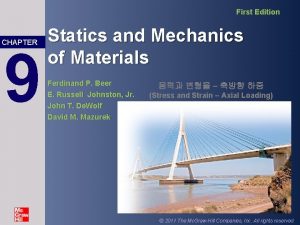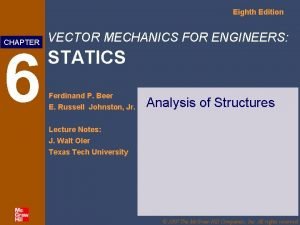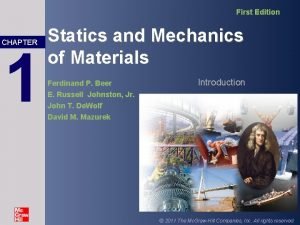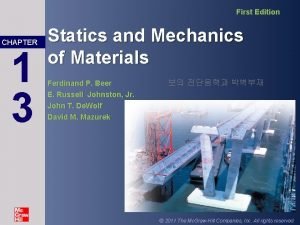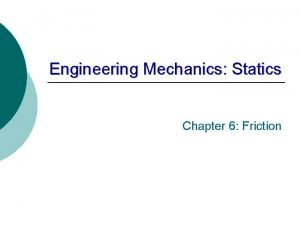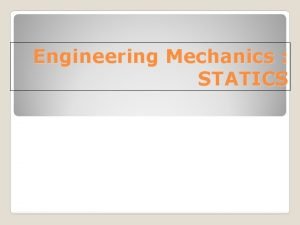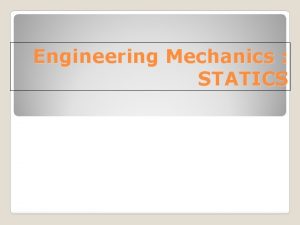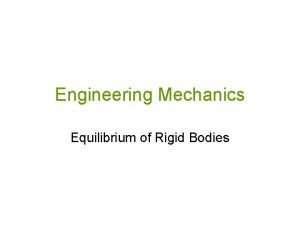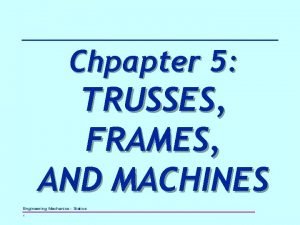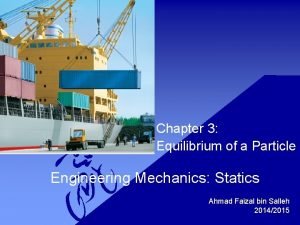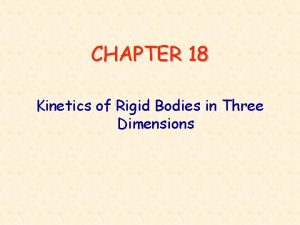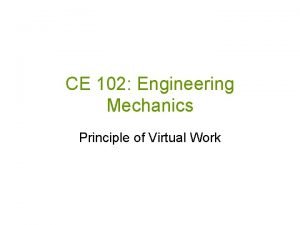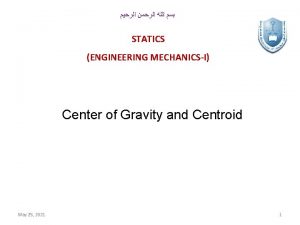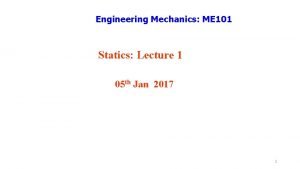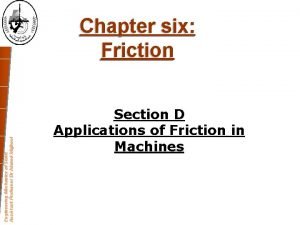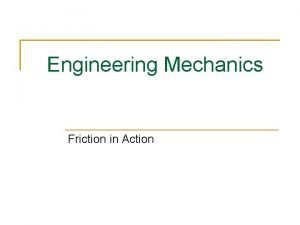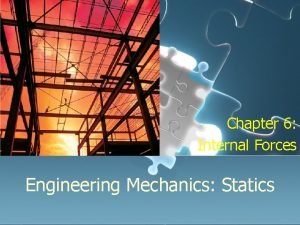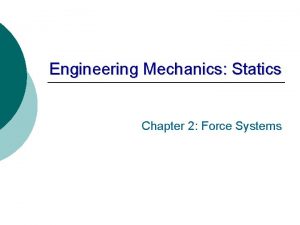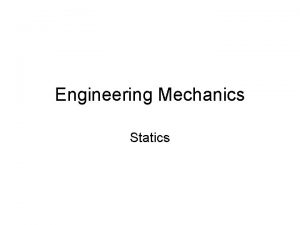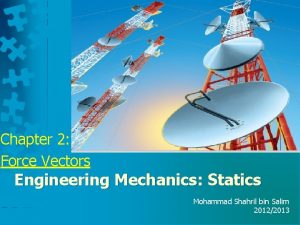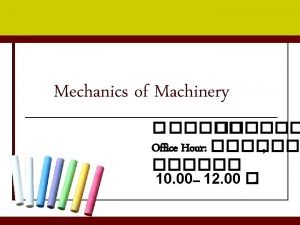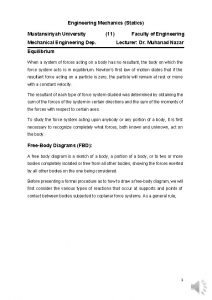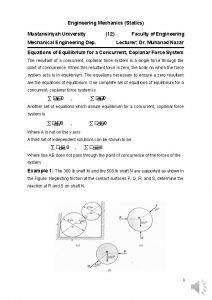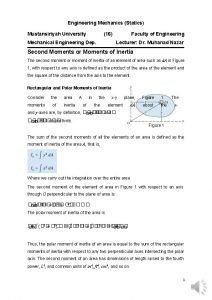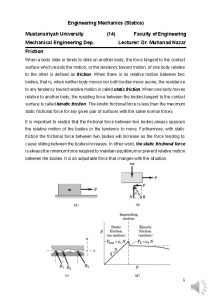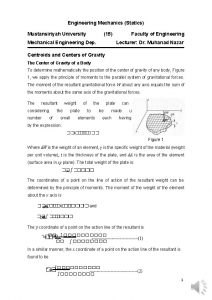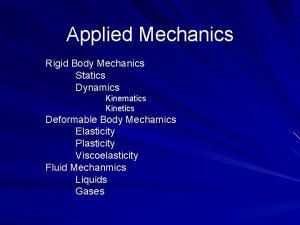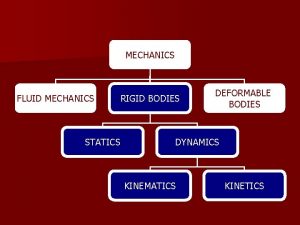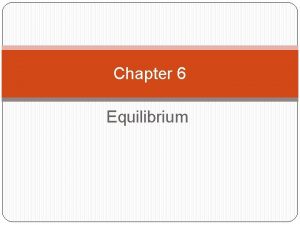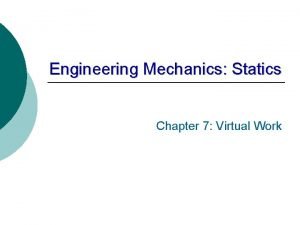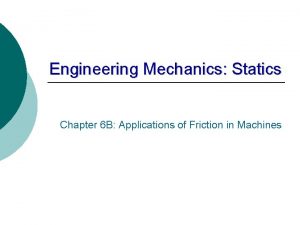Engineering Mechanics Statics Chapter 2 Force Systems Force




































- Slides: 36

Engineering Mechanics: Statics Chapter 2: Force Systems

Force Systems Part A: Two Dimensional Force Systems

Force ¡ An action of one body on another Vector quantity ¡ External and Internal forces ¡ Mechanics of Rigid bodies: Principle of Transmissibility ¡ • • ¡ Specify magnitude, direction, line of action No need to specify point of application Concurrent forces • Lines of action intersect at a point

Vector Components ¡ A vector can be resolved into several vector components ¡ Vector sum of the components must equal the original vector ¡ Do not confused vector components with perpendicular projections

Rectangular Components ¡ 2 D force systems • • y q Most common 2 D resolution of a force vector Express in terms of unit vectors , x Scalar components – can be positive and negative

2 D Force Systems ¡ Rectangular components are convenient for finding the sum or resultant of two (or more) forces which are concurrent Actual problems do not come with reference axes. Choose the most convenient one!

Example 2. 1 ¡ Solution The link is subjected to two forces F 1 and F 2. Determine the magnitude and direction of the resultant force.

Example 2/1 (p. 29) Determine the x and y scalar components of each of the three forces

Rectangular components ¡ Unit vectors • y qy qx x = Unit vector in direction of

Problem 2/4 The line of action of the 34 -k. N force runs through the points A and B as shown in the figure. (a) Determine the x and y scalar component of F. (b) Write F in vector form.

Moment ¡ ¡ ¡ In addition to tendency to move a body in the direction of its application, a force tends to rotate a body about an axis. The axis is any line which neither intersects nor is parallel to the line of action This rotational tendency is known as the moment M of the force l Proportional to force F and the perpendicular distance from the axis to the line of action of the force d l The magnitude of M is M = Fd

Moment ¡ ¡ The moment is a vector M perpendicular to the plane of the body. Sense of M is determined by the right-hand rule l l Direction of the thumb = arrowhead Fingers curled in the direction of the rotational tendency ¡ In a given plane (2 D), we may speak of moment about a point which means moment with respect to an axis normal to the plane and passing through the point. ¡ +, - signs are used for moment directions – must be consistent throughout the problem!

Moment ¡ ¡ A vector approach for moment calculations is proper for 3 D problems. Moment of F about point A maybe represented by the cross-product M=rx. F where r = a position vector from point A to any point on the line of action of F M = Fr sin a = Fd

Example 2/5 (p. 40) Calculate the magnitude of the moment about the base point O of the 600 -N force by using both scalar and vector approaches.

Problem 2/43 (a) Calculate the moment of the 90 -N force about point O for the condition q = 15º. (b) Determine the value of q for which the moment about O is (b. 1) zero (b. 2) a maximum

Couple ¡ Moment produced by two equal, opposite, and noncollinear forces = couple M = F(a+d) – Fa = Fd l ¡ Moment of a couple has the same value for all moment center Vector approach M = r. A x F + r. B x (-F) = (r. A - r. B) x F = r x F l Couple M is a free vector

Couple ¡ Equivalent couples l Change of values F and d l Force in different directions but parallel plane l Product Fd remains the same

Force-Couple Systems ¡ ¡ Replacement of a force by a force and a couple Force F is replaced by a parallel force F and a counterclockwise couple Fd Example Replace the force by an equivalent system at point O Also, reverse the problem by the replacement of a force and a couple by a single force

Problem 2/67 The wrench is subjected to the 200 -N force and the force P as shown. If the equivalent of the two forces is a for R at O and a couple expressed as the vector M = 20 k. N. m, determine the vector expressions for P and R

Resultants ¡ The simplest force combination which can replace the original forces without changing the external effect on the rigid body ¡ Resultant = a force-couple system

Resultants ¡ Choose a reference point (point O) and move all forces to that point ¡ Add all forces at O to form the resultant force R and add all moment to form the resultant couple MO ¡ Find the line of action of R by requiring R to have a moment of MO

Problem 2/79 Replace three forces acting on the bent pipe by a single equivalent force R. Specify the distance x from point O to the point on the x-axis through which the line of action of R passes.

Force Systems Part B: Three Dimensional Force Systems

Three-Dimensional Force System ¡ Rectangular components in 3 D • Express in terms of unit vectors • • cosqx, cosqy , cosqz are the direction cosines cosqx = l, cosqy = m, cosq z= n , ,

Three-Dimensional Force System ¡ Rectangular components in 3 D • If the coordinates of points A and B on the line of action are known, • If two angles q and f which orient the line of action of the force are known,

Problem 2/98 ¡ The cable exerts a tension of 2 k. N on the fixed bracket at A. Write the vector expression for the tension T.

Three-Dimensional Force System ¡ Dot product l l Orthogonal projection of Fcosa of F in the direction of Q Orthogonal projection of Qcosa of Q in the direction of F ¡ We can express Fx = Fcosqx of the force F as Fx = ¡ If the projection of F in the n-direction is

Example ¡ Find the projection of T along the line OA

Moment and Couple ¡ Moment of force F about the axis through point O is MO = r x F l l l ¡ r runs from O to any point on the line of action of F Point O and force F establish a plane A The vector Mo is normal to the plane in the direction established by the right-hand rule Evaluating the cross product

Moment and Couple ¡ Moment about an arbitrary axis known as triple scalar product (see appendix C/7) ¡ The triple scalar product may be represented by the determinant where l, m, n are the direction cosines of the unit vector n

Sample Problem 2/10 A tension T of magniture 10 k. N is applied to the cable attached to the top A of the rigid mast and secured to the ground at B. Determine the moment Mz of T about the z-axis passing through the base O.

Resultants ¡ A force system can be reduced to a resultant force and a resultant couple

Wrench Resultants ¡ Any general force systems can be represented by a wrench

Problem 2/143 ¡ ¡ Replace the two forces and single couple by an equivalent forcecouple system at point A Determine the wrench resultant and the coordinate in the xy plane through which the resultant force of the wrench acts

Resultants ¡ Special cases • Concurrent forces – no moments about point of concurrency • Coplanar forces – 2 D • Parallel forces (not in the same plane) – magnitude of resultant = algebraic sum of the forces • Wrench resultant – resultant couple M is parallel to the resultant force R • Example of positive wrench = screw driver

Problem 2/142 ¡ ¡ Replace the resultant of the force system acting on the pipe assembly by a single force R at A and a couple M Determine the wrench resultant and the coordinate in the xy plane through which the resultant force of the wrench acts
 Concurrent force system
Concurrent force system Engineering mechanics: statics in si units answers
Engineering mechanics: statics in si units answers Engineering elegant systems: theory of systems engineering
Engineering elegant systems: theory of systems engineering Elegant systems
Elegant systems Vector mechanics for engineers statics 12th
Vector mechanics for engineers statics 12th Line of action of force
Line of action of force Vector mechanics for engineers: statics 10th edition
Vector mechanics for engineers: statics 10th edition Mechanics
Mechanics Vector mechanics for engineers statics 10th edition
Vector mechanics for engineers statics 10th edition Vector mechanics for engineers 10th edition
Vector mechanics for engineers 10th edition Statics force vectors
Statics force vectors Statics of structures
Statics of structures Friction chapter in engineering mechanics
Friction chapter in engineering mechanics Mechanics for engineers
Mechanics for engineers Shear force statics
Shear force statics Two force member
Two force member Chapter 4 force system resultants
Chapter 4 force system resultants Equilibrium engineering mechanics
Equilibrium engineering mechanics Mechanics of materials
Mechanics of materials Statics
Statics Statics chapter 6
Statics chapter 6 Statics chapter 1
Statics chapter 1 Statics
Statics The 30 kg homogeneous cylinder of 400mm diameter
The 30 kg homogeneous cylinder of 400mm diameter Center of gravity in engineering mechanics
Center of gravity in engineering mechanics Centroid formula statics
Centroid formula statics Equilibrium of rigid bodies in engineering mechanics
Equilibrium of rigid bodies in engineering mechanics Determine the force in members fh gh and gi
Determine the force in members fh gh and gi Particle equilibrium in 2d and 3d engineering mechanics
Particle equilibrium in 2d and 3d engineering mechanics Kinetics of a rigid body
Kinetics of a rigid body Virtual work problems in engineering mechanics
Virtual work problems in engineering mechanics Centroid and centre of gravity in engineering mechanics
Centroid and centre of gravity in engineering mechanics Me 101 engineering mechanics
Me 101 engineering mechanics Centroid statics
Centroid statics What is β in the equation t2 = t1eµβ
What is β in the equation t2 = t1eµβ Friction engineering mechanics
Friction engineering mechanics Internal forces in structures engineering mechanics
Internal forces in structures engineering mechanics

